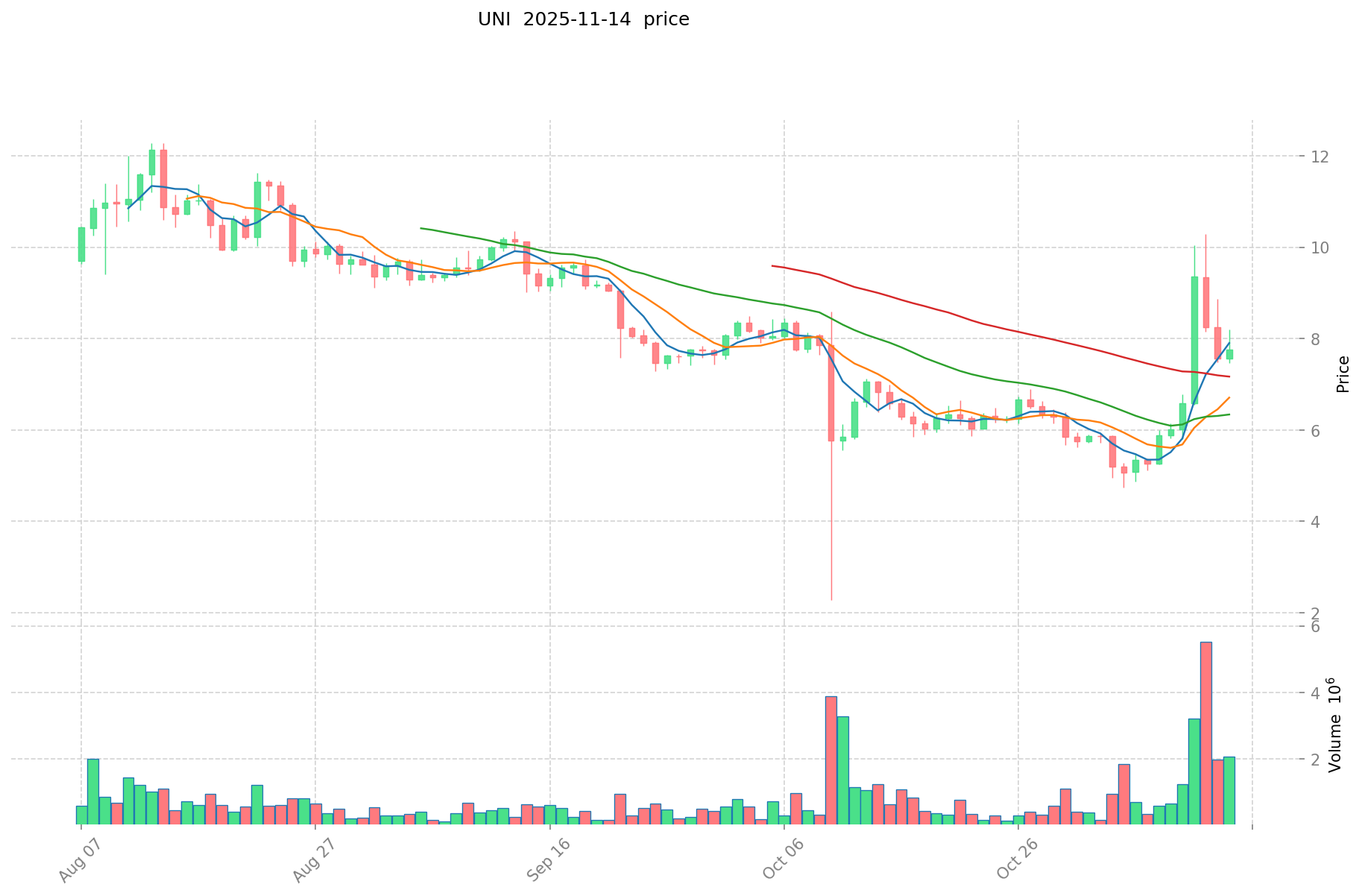What is UNI: The Decentralized Exchange Protocol Revolutionizing DeFi Trading
Uniswap's Positioning and Significance
In 2018, Hayden Adams launched Uniswap (UNI), aiming to solve liquidity issues in decentralized exchanges.
As the first automated market maker (AMM) protocol on Ethereum, Uniswap plays a crucial role in the DeFi ecosystem.
As of 2025, Uniswap has become a cornerstone of decentralized trading, boasting significant trading volume and an active developer community. This article will delve into its technical architecture, market performance, and future potential.
Origins and Development History
Background
Uniswap was created by Hayden Adams in 2018, with the goal of addressing liquidity problems in decentralized exchanges.
It emerged during the rise of decentralized finance (DeFi), aiming to enable permissionless and efficient token swaps on Ethereum.
Uniswap's launch brought new possibilities for decentralized trading and liquidity provision.
Key Milestones
- 2018: Mainnet launch, introducing the automated market maker model.
- 2020: Uniswap V2 upgrade, bringing improved price oracles and flash swaps.
- 2020: UNI token launch, with price reaching $6.96 within 24 hours.
- 2021: Uniswap V3 launch, introducing concentrated liquidity and multiple fee tiers.
With support from its community and Uniswap Foundation, Uniswap continues to enhance its technology, security, and real-world applications.
How Does Uniswap Work?
Decentralized Control
Uniswap operates on the Ethereum network, free from control by banks or governments.
Nodes collaborate to validate transactions, ensuring system transparency and attack resistance, empowering users with greater autonomy and enhancing network resilience.
Blockchain Core
Uniswap's smart contracts run on Ethereum's blockchain, a public, immutable digital ledger recording every transaction.
Transactions are grouped into blocks and linked through cryptographic hashes, forming a secure chain.
Anyone can view records, establishing trust without intermediaries.
Layer 2 solutions and optimizations further enhance performance.
Ensuring Fairness
Uniswap uses an automated market maker (AMM) model to facilitate trades and prevent manipulation.
Liquidity providers supply assets to pools and earn fees, maintaining market efficiency.
Its innovations include concentrated liquidity and multiple fee tiers for improved capital efficiency.
Secure Transactions
Uniswap leverages Ethereum's public-private key cryptography to secure transactions:
- Private keys (like secret passwords) are used to sign transactions
- Public keys (like account numbers) are used to verify ownership
This mechanism ensures fund security, with transactions remaining pseudonymous.
Additional security features include time-weighted average price (TWAP) oracles and flash swap protection.
UNI's Market Performance
Circulation Overview
As of November 14, 2025, UNI's circulating supply is 629,892,750.2713912 tokens, with a total supply of 1,000,000,000 tokens.
Price Fluctuations
UNI reached its all-time high of $44.92 on May 3, 2021. Its lowest price was $1.03, occurring on September 17, 2020. These fluctuations reflect market sentiment, adoption trends, and external factors.
Click to view the current UNI market price

On-Chain Metrics
- Number of Holders: 383,063 (reflecting user participation)
Uniswap Ecosystem Applications and Partnerships
Core Use Cases
Uniswap's ecosystem supports various applications:
- DeFi: Uniswap, providing decentralized trading.
- Liquidity Provision: Automated market making, enabling users to contribute liquidity and earn fees.
Strategic Collaborations
Uniswap has established partnerships with prominent blockchain projects and DeFi protocols, enhancing its technical capabilities and market influence. These partnerships have provided a solid foundation for Uniswap's ecosystem expansion.
Controversies and Challenges
Uniswap faces the following challenges:
- Technical Issues: Scalability bottlenecks and high gas fees on Ethereum
- Regulatory Risks: Potential scrutiny from financial regulators
- Competitive Pressure: Rising competition from other DEXs and layer-2 solutions
These issues have sparked discussions within the community and market, driving Uniswap's continuous innovation.
Uniswap Community and Social Media Atmosphere
Fan Enthusiasm
Uniswap's community is vibrant, with 383,063 holders as of November 14, 2025.
On X platform, related posts and hashtags like #Uniswap frequently trend.
Price movements and protocol upgrades ignite community enthusiasm.
Social Media Sentiment
Sentiment on X shows polarization:
- Supporters praise Uniswap's decentralized nature and liquidity provision, viewing it as the "future of decentralized finance".
- Critics focus on high gas fees and potential regulatory challenges.
Recent trends indicate generally bullish sentiment during market uptrends.
Hot Topics
X users actively discuss Uniswap's governance proposals, protocol upgrades, and market impact, highlighting both its transformative potential and the challenges in mainstream adoption.
More Information Sources for Uniswap
- Official Website: Visit Uniswap's official website for features, use cases, and latest updates.
- X Updates: On X platform, Uniswap uses @Uniswap, covering protocol updates, community events, and ecosystem news.
Uniswap's Future Roadmap
- Ecosystem Goals: Expand cross-chain functionality and improve liquidity efficiency
- Long-term Vision: Become the leading decentralized trading protocol across multiple blockchains
How to Participate in Uniswap?
- Purchase Channels: Buy UNI on Gate.com
- Storage Solutions: Use Web3 wallets for secure storage
- Participate in Governance: Join community decisions through the Uniswap governance forum
- Build the Ecosystem: Visit Uniswap's developer documentation to build DApps or contribute code
Summary
Uniswap has redefined decentralized trading through blockchain technology, offering transparency, security, and efficient token swaps. Its active community, rich resources, and strong market performance make it stand out in the cryptocurrency field. Despite facing regulatory uncertainties and technical challenges, Uniswap's innovative spirit and clear roadmap position it prominently in the future of decentralized technologies. Whether you're a newcomer or an experienced player, Uniswap is worth watching and participating in.
FAQ
What kind of food is uni?
Uni is not a food. It's the ticker symbol for Uniswap, a decentralized cryptocurrency exchange protocol on Ethereum.
What does a uni mean?
UNI refers to the native token of Uniswap, a leading decentralized exchange protocol on Ethereum. It's used for governance and liquidity provision in the Uniswap ecosystem.
What does uni taste like?
UNI doesn't have a taste. It's a cryptocurrency token, not a food item. UNI is the governance token of Uniswap, a decentralized exchange protocol on Ethereum.
What is uni slang for?
UNI is slang for Uniswap, a popular decentralized exchange protocol on Ethereum. It's also the name of Uniswap's governance token.
Share
Content